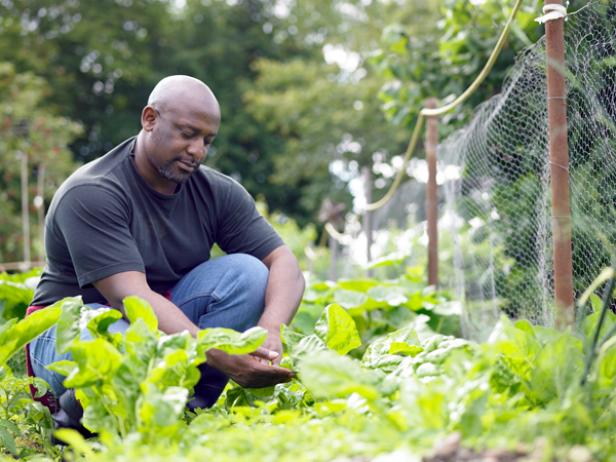Never miss your harvest window again.
Whether you’re a beginner or a master gardener, sometimes it can be difficult to know when it’s time to harvest your crops. And to get the most delicious-tasting vegetables from your garden, harvesting them when they are at their peak flavor is important. After all, you’ve put in the hard work nurturing them all season long.
Although the perfect harvesting week or month can vary by region and growing conditions, you can always rely on your produce to let you know when it’s ready. Let your plants do the talking.
When your plants start to put off indicators that it may be time to pick, the only fail-safe way to guarantee your vegetables and fruits are at optimum picking time is to taste test.
Timing for harvesting your food is primarily dictated by the length of time they have been growing. This information is found on seed packets, as well as other helpful tips, but there are other signs of when you may want to start taste-testing your crops, and it’s all here!
Note: If you end up picking a crop a little too early, don’t fret! Most of the time, it will ripen beautifully on your kitchen counter.

John Howard/Getty
Broccoli
This cruciferous green can be grown year-round in temperate climates and is sweeter and less bitter when harvested in the fall. The answer for when to pick this veggie lies in your fingertips. When touching the head or ‘bud’ (broccoli is a cluster of flower buds), if the head is firm and tight and about the diameter that is expected for the variety you’ve grown, (this information is on the seed packet) then it’s ready to be harvested. If spaces are forming between the florets or if it “gives,” it’s past its prime. But there’s good news: you can still eat it! Don’t be shocked if the size of your homegrown broccoli isn’t supermarket size or if it tastes better.
Seed to Harvest Time: 100-150 days
Brussel Sprouts
An interesting vegetable to watch grow on its unique structure of a stem, you can start picking the sprouts when they reach one to two inches in diameter, are bright green and firm to the touch. Lower sprouts will mature first, with upper sprouts maturing a day to a few days later.
Seed to Harvest Time: 98-110 days
Butternut Squash
Known as a “winter squash” due to its ability to store well in the winter, this sweet veggie will put forth many indicators to let you know when it’s ripe. First, look at the stem; if it’s dried and brown in color that’s a good sign that you may be having squash for dinner. Next, try and push your fingernail into the skin of the squash; if it’s tough, that’s another good sign it’s harvest time. Lastly, check the color of the skin – butternut squash has a solid tan or tan-orange shade when it’s ripe and ready to go.
Seed to Harvest Time: 95-115 days
Carrots
This fall crop will conveniently mature roughly at the same time providing a pleasant harvest. Although carrots are grown underground and can be hard to judge, note that the tops of the carrot will show at the soil line, and eventually they will reach the diameter for your variety. If the diameter looks good, chances are the length of your carrot will be as well. You want the carrot to be vibrant in color when harvesting.
To harvest, loosen the soil around the carrot with a spade or trowel before pulling up from the greens; this will help avoid breaking off the green from the carrot roots.
Seeds to Harvest Time: 60-80 Days
Cauliflower
While most varieties of cauliflower are white, some are purple or orange which makes for gorgeous cauliflower rice! The traditional white-floret variety, when ready for harvest, should measure about six to eight inches in width and should feel firm and compact to the touch. The head may be smaller when harvested but needs to be already opening up. Leaving them in the dirt too long will result in brown spots and a ‘mealy’ texture.
Seed to Harvest Time: 55-100 days
Eggplant
Once this purple plant is fully developed and small, it might be harvest time. Take a look at the skin which should be glossy and thin while the inner flesh should be cream-colored, and there should be no visible seeds. You want the fruit to feel firm to the touch. For beginner eggplant growers, you may want to cut into the fruit to check out the color of the flesh and size of seeds. Once you get the hang of it, cutting into the fruit won’t be necessary.
Seed to Harvest Time: 100-120 days
Kale
Kale is a fast-growing leafy green that has a long harvesting period which is great for kale lovers! While different species of kale reach maturity at different times, they can be picked all throughout the season. Baby kale is harvested before reaching maturity which means it will be smaller in size and tender to the touch. Mature kale leaves are ready for the pickin’ when the leaves have reached roughly the size of your hand.
Seed to Harvest Time: 50-75 days for mature kale, and as early as 25 days for baby kale
Onions
Let the leaves do all the talking. Although 13 leaves are rumored to be the “perfect” amount when maturity is reached, it really depends on your variety as some onions mature with fewer leaves.
The next thing to examine is to see if your onion has a “soft neck” (the area where the leaves meet the bulb). If the neck is softening, you may be nearing a harvest. Next up, when the tops of the onions fall over this 100 percent means soft neck and you should begin harvesting.
Seed to Harvest Time: 100-120 days
Potatoes
One of the best visual clues of potato harvest time is the condition of the vines. Let your vines grow until they die, turn brown and dry out. After the potato vines have died, leave your potatoes in the ground for another two-to-three weeks. When your vines start to dry, cut back significantly on watering; the decreased watering helps the potatoes cure which makes for better storage. Carefully dig up one potato and check for maturity – rub the potato’s skin with your thumb, if the skin slides off easily, it’s not ready. Leave the rest of the crop in the ground and check another potato in a few days and before you know it, you’ll be having mashed potatoes.
Seed to Harvest Time: 70-120 days
Pumpkin
Pumpkins start off green in color, but when ready to be picked, they turn a solid orange color or the color of the variety you have chosen. Head on over to the stem and if it feels hard and dry, it’s time. Lastly, the skin of the pumpkin should feel hard as well. Use your fingernail to gently press down on the pumpkin; if it dents but doesn’t puncture the skin, you’re ready to harvest.
Seed to Harvest Time: 90-120 days
Spinach
This fast-growing cool-season crop tends to bolt or get bitter when temperatures rise and the sun is high, making this a great veggie to enjoy in the cooler months. The neat thing about harvesting spinach is you can choose the harvesting time. If you cut the leaves when they are smaller, you’ll have “baby spinach” which will provide a sweeter taste or you can wait until the leaves grow larger. When looking to add spinach to your dish, it’s best to harvest the spinach as close as possible to mealtime as it makes for the best texture.
Seed to Harvest Time: 40-65 days
Watermelon
Growing watermelon is nothing short of delicious! To make sure your melon is ripe for the picking the first thing you should do is check the “field spot” on the underside of the watermelon where it touched or touches the ground. This spot should be a buttery yellow to dark yellow. If it’s a shade of white, it’s not ready. Next, give it a little tap; the classic thump test with your hand should produce a deep hollow sound when fully ripe. Lastly, check the tendril which is located where the stem meets the vine. If the tendril is still curly and green, your melon is still growing; wait a few days and check on it again.
Seed to Harvest Time: 75-100 days
Getting to know your plant’s language takes time, and with practice and patience, you will feel more comfortable each season when it comes to harvesting time.

